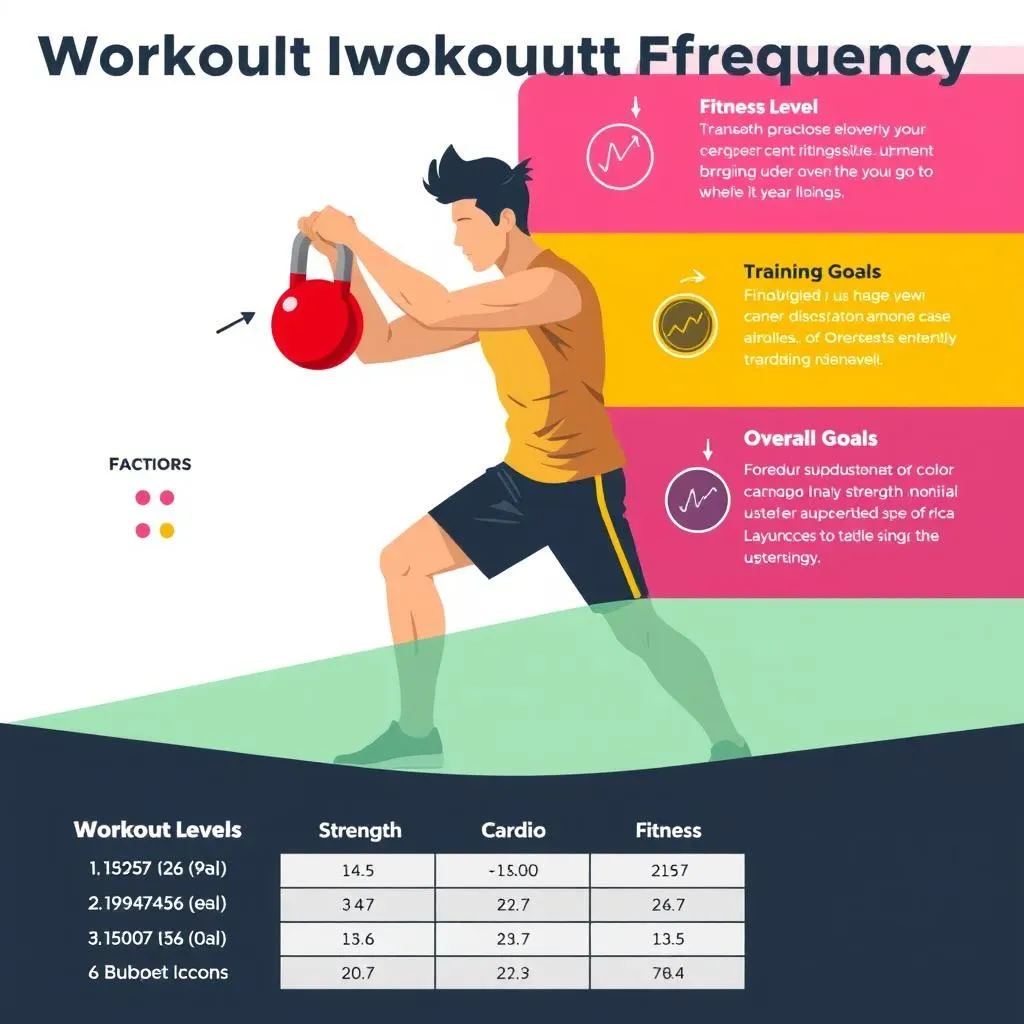Table of Contents
So, you're hooked on kettlebells, huh? The swings, the snatches, the Turkish get-ups – it's a full-body party. But a big question looms: how often should you workout with kettlebells to actually see results without burning out or, worse, getting injured? It's a valid concern. Jumping in headfirst without a plan is a recipe for disaster. This isn't just about throwing weight around; it's about intelligent training.
Decoding Kettlebell Workout Frequency: Finding Your Sweet Spot

Decoding Kettlebell Workout Frequency: Finding Your Sweet Spot
The "Just Right" Kettlebell Zone
Alright, so you're itching to swing that kettlebell, but how many times a week is the magic number? The truth is, there's no one-size-fits-all answer. Think of it like Goldilocks and the Three Bears – you don't want to do too little and see no progress, or too much and end up injured and burnt out. You need to find that "just right" zone where you're challenging your body enough to stimulate growth but also allowing it adequate time to recover and rebuild.
That sweet spot depends on a bunch of factors, which we'll dive into shortly. But a good starting point for many people is 2-3 kettlebell workouts per week, especially if you're new to this style of training. This allows you to build a solid foundation of strength and technique without overwhelming your system. And remember, consistency is key! Showing up regularly, even for shorter sessions, is far more effective than sporadic, marathon workouts.
The Art of Listening to Your Body
Beyond the numbers, the most crucial element in determining your kettlebell workout frequency is listening to your body. Are you feeling energized and recovered between sessions, or are you constantly sore, fatigued, and dreading your next workout? Your body is an incredibly sophisticated feedback machine, and it's constantly sending you signals about what it needs. Ignoring these signals is a surefire way to derail your progress and increase your risk of injury.
Pay attention to things like your energy levels, sleep quality, mood, and any aches or pains you might be experiencing. If you're consistently feeling run down, it's a sign that you need to scale back your training volume or intensity. On the other hand, if you're feeling great and eager for more, you might be able to safely increase your workout frequency. It's all about finding that balance and adjusting as needed.
Factor | Too Little | Just Right | Too Much |
|---|---|---|---|
Energy Levels | Sluggish, unmotivated | Energetic, ready to train | Exhausted, drained |
Muscle Soreness | None | Mild, manageable | Severe, debilitating |
Sleep Quality | Restless, insomnia | Deep, restorative | Difficulty falling asleep |
Factors Influencing How Often to Workout with Kettlebells

Factors Influencing How Often to Workout with Kettlebells
Your Current Fitness Level
Let's be real, a seasoned athlete who's been crushing kettlebell workouts for years will have a different starting point than someone who's just picked up their first bell. If you're a newbie, your body needs time to adapt to the unique demands of kettlebell training. Start slow, focusing on mastering proper form and building a solid foundation of strength and stability. Trying to do too much too soon is a surefire way to wind up injured and discouraged.
On the other hand, if you're already in decent shape, you can likely handle a higher frequency of kettlebell workouts. However, even experienced lifters need to be mindful of overtraining. Kettlebells are incredibly effective, but they're also demanding on your joints and connective tissues. So, regardless of your fitness level, it's crucial to progress gradually and listen to your body's feedback.
Your Training Goals
What are you hoping to achieve with your kettlebell training? Are you looking to build strength, improve your cardio, lose weight, or simply improve your overall fitness? Your goals will play a significant role in determining how often you should be working out with kettlebells. For example, if your primary goal is to build strength, you might focus on heavier weights and lower reps, with longer rest periods between sets. This type of training typically requires more recovery time, so you might only workout with kettlebells 2-3 times per week.
On the other hand, if your goal is to improve your cardio or lose weight, you might focus on lighter weights and higher reps, with shorter rest periods. This type of training can be done more frequently, perhaps 3-5 times per week, but it's still important to listen to your body and avoid overtraining. Ultimately, the best workout frequency is the one that allows you to make consistent progress toward your goals without sacrificing your health and well-being.
Goal | Suggested Frequency | Workout Style |
|---|---|---|
Strength Building | 2-3 times per week | Heavier weights, lower reps, longer rest |
Cardio/Weight Loss | 3-5 times per week | Lighter weights, higher reps, shorter rest |
Overall Fitness | 3-4 times per week | Varied weights and reps, moderate rest |
Sample Kettlebell Workout Schedules: Beginner to Advanced

Sample Kettlebell Workout Schedules: Beginner to Advanced
Beginner Kettlebell Schedule (2-3 workouts per week)
Alright, newbies, listen up! When you're just starting out with kettlebells, it's all about mastering the basics and building a solid foundation. Don't even think about trying to do too much too soon. Your body needs time to adapt to the unique demands of kettlebell training. These workouts should focus on fundamental movements and proper form, with lighter weights and higher reps. Remember, quality over quantity is the name of the game here. These sample kettlebell workout schedules are designed to be a starting point, adjust as needed based on your individual progress and recovery.
Focus on movements like swings, goblet squats, rows, and presses. These exercises will help you develop the strength, stability, and coordination you need to progress to more advanced movements down the road. And don't be afraid to modify exercises as needed to accommodate your current fitness level. For example, if you can't do a full push-up, start with push-ups against a wall or on your knees.
- Workout A: Kettlebell Swings (3 sets of 10-15 reps), Goblet Squats (3 sets of 8-12 reps), Kettlebell Rows (3 sets of 8-12 reps per side)
- Workout B: Kettlebell Deadlifts (3 sets of 8-12 reps), Kettlebell Presses (3 sets of 6-10 reps per side), Plank (3 sets, hold for 30-60 seconds)
Intermediate Kettlebell Schedule (3-4 workouts per week)
you've mastered the basics and you're ready to take things to the next level. Now it's time to increase the intensity and volume of your workouts. This means using heavier weights, performing more reps, and incorporating more challenging exercises. You can also start to experiment with different workout formats, such as circuits and complexes. Circuits involve performing a series of exercises back-to-back with minimal rest, while complexes involve performing a series of exercises with the same kettlebell without putting it down.
Some of the exercises you might incorporate into your intermediate kettlebell workouts include Turkish get-ups, snatches, and cleans. These are more complex movements that require a good level of strength, coordination, and stability. Be sure to practice these exercises with lighter weights before progressing to heavier loads. Remember to always prioritize proper form over lifting heavy weights. It's better to use a lighter weight and perform the exercise correctly than to use a heavier weight and risk injury.
Workout | Exercises | Sets/Reps |
|---|---|---|
A | Kettlebell Swings, Goblet Squats, Push-ups | 3 sets of 15 reps each |
B | Turkish Get-Ups, Kettlebell Rows, Plank | 3 sets of 5 reps per side, 3 sets of 10 reps, 3 sets of 45 seconds |
C | Kettlebell Cleans, Kettlebell Presses, Lunges | 3 sets of 8 reps each side |
Advanced Kettlebell Schedule (4-5 workouts per week)
Alright, kettlebell masters, this is where things get serious. At this level, you're likely already very strong, fit, and coordinated. Your workouts should be incredibly challenging, pushing you to your limits both physically and mentally. This might involve using very heavy weights, performing advanced exercises, and incorporating high-intensity training techniques. You can also start to specialize your training based on your specific goals. For example, if you're training for a kettlebell competition, you might focus on exercises like snatches and jerks.
However, even at this level, it's crucial to listen to your body and avoid overtraining. Advanced athletes are often the most prone to overtraining because they're constantly pushing themselves to the limit. Be sure to get plenty of rest, eat a healthy diet, and manage your stress levels. And don't be afraid to take deload weeks when needed. A deload week is a week where you significantly reduce your training volume and intensity to allow your body to recover and rebuild.
Avoiding Overtraining: Listen to Your Body When Working Out with Kettlebells

Avoiding Overtraining: Listen to Your Body When Working Out with Kettlebells
The Overtraining Trap: More Isn't Always Better
Let's get one thing straight: pushing yourself is essential for progress, but there's a fine line between pushing and overdoing it. Overtraining is a sneaky beast that can creep up on you, especially when you're fired up about kettlebells. You start feeling like you can conquer the world with a swing, so you add more reps, more sets, more workouts, without giving your body a chance to recover. And before you know it, you're stuck in a cycle of fatigue, soreness, and diminishing returns. Trust me, I've been there, and it's not a fun place to be.
Overtraining isn't just about physical exhaustion; it can also mess with your hormones, immune system, and even your mental health. It can lead to injuries, burnout, and a whole host of other problems. That's why it's so crucial to listen to your body and recognize the signs of overtraining before it's too late. Think of your body as a high-performance sports car – you need to give it regular maintenance and tune-ups to keep it running smoothly. Ignoring the warning lights is a recipe for a breakdown.
Decoding Your Body's Signals: What to Watch Out For
So, how do you know if you're teetering on the edge of overtraining? Your body will give you clues, but you need to be paying attention. Some of the most common signs of overtraining include persistent muscle soreness, fatigue that doesn't go away with rest, decreased performance, sleep disturbances, loss of appetite, increased irritability, and a weakened immune system. If you're experiencing several of these symptoms, it's a red flag that you need to back off and give your body some TLC.
It's also important to track your workouts and monitor your progress. Are you consistently getting stronger and faster, or are you plateauing or even regressing? If you're not seeing the results you expect, it could be a sign that you're overtraining and your body isn't able to adapt to the stress you're putting on it. Remember, progress isn't always linear. There will be times when you feel like you're hitting a wall, and that's okay. The key is to recognize when you need to rest and recover so you can come back stronger.
Symptom | Possible Cause | Action |
|---|---|---|
Persistent Muscle Soreness | Inadequate recovery | Reduce workout volume/intensity, prioritize rest |
Decreased Performance | Overtraining, fatigue | Take a deload week, adjust training plan |
Sleep Disturbances | Hormonal imbalances, stress | Improve sleep hygiene, manage stress |
Maximizing Results: Optimizing Your Kettlebell Workout Frequency

Maximizing Results: Optimizing Your Kettlebell Workout Frequency
Fueling Your Kettlebell Fire: Nutrition and Recovery
Alright, you're crushing your kettlebell workouts, avoiding overtraining, and listening to your body. But there's one crucial piece of the puzzle we haven't talked about yet: nutrition and recovery. You can't expect to maximize your results if you're fueling your body with junk food and skimping on sleep. Think of your body as a high-performance engine – it needs premium fuel and regular maintenance to run at its best. Proper nutrition and recovery are essential for repairing muscle tissue, replenishing energy stores, and optimizing hormone levels.
That means eating a balanced diet rich in protein, complex carbohydrates, and healthy fats. Protein is crucial for muscle repair and growth, while carbohydrates provide the energy you need to power through your workouts. Healthy fats are important for hormone production and overall health. And don't forget to stay hydrated! Water is essential for virtually every bodily function, including muscle function and recovery. Aim to drink plenty of water throughout the day, especially before, during, and after your workouts.
Strategic Kettlebell Programming: Variety is the Spice of Gains
Sticking to the same old kettlebell routine week after week is a surefire way to hit a plateau and stall your progress. Your body is incredibly adaptable, and it will quickly get used to the same movements and intensities. That's why it's so important to incorporate variety into your kettlebell programming. This doesn't mean you need to constantly be changing exercises, but it does mean you should be varying the sets, reps, weights, and rest periods. You can also experiment with different workout formats, such as circuits, complexes, and interval training.
For example, one week you might focus on heavier weights and lower reps to build strength, while the next week you might focus on lighter weights and higher reps to improve your endurance. You can also incorporate different kettlebell exercises to target different muscle groups. The key is to keep your body guessing and challenge it in new and different ways. This will not only prevent plateaus but also make your workouts more enjoyable and engaging.
Programming Strategy | Description | Benefits |
|---|---|---|
Progressive Overload | Gradually increasing the weight, reps, or sets over time | Stimulates muscle growth and strength gains |
Variation | Incorporating different exercises, sets, reps, and rest periods | Prevents plateaus and keeps workouts engaging |
Deloading | Reducing training volume and intensity to allow for recovery | Reduces risk of overtraining and injury |
Mastering the Kettlebell: Your Personalized Path to Fitness
Finding the perfect kettlebell workout frequency is a journey, not a destination. There's no one-size-fits-all answer to how often should you workout with kettlebells. It's about understanding your body, your goals, and your limits. By carefully considering the factors we've discussed, experimenting with different schedules, and prioritizing recovery, you can create a sustainable and effective kettlebell routine that delivers real results. So, grab your kettlebell, listen to your body, and enjoy the process of becoming a stronger, healthier you!